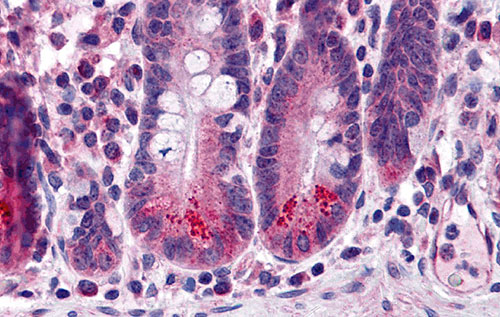BRUCE Antibody
- 产品详情
- 实验流程
- 背景知识
Application
| E, IHC-P |
|---|---|
| Primary Accession | Q9NR09 |
| Other Accession | NP_057336, 153792694 |
| Reactivity | Human |
| Host | Rabbit |
| Clonality | Polyclonal |
| Isotype | IgG |
| Calculated MW | 530269 Da |
| Concentration (mg/ml) | 1 mg/mL |
| Conjugate | Unconjugated |
| Application Notes | BRUCE antibody can be used for detection of BRUCE by immunohistochemistry at 5 µg/mL. |
| Gene ID | 57448 |
|---|---|
| Other Names | BRUCE Antibody: BRUCE, APOLLON, KIAA1289, Baculoviral IAP repeat-containing protein 6, BIR repeat-containing ubiquitin-conjugating enzyme, BRUCE, baculoviral IAP repeat-containing protein 6 |
| Target/Specificity | BIRC6; BRUCE antibody is human specific. Multiple isoforms of BRUCE are known to exist. |
| Reconstitution & Storage | BRUCE antibody can be stored at 4℃ for three months and -20℃, stable for up to one year. As with all antibodies care should be taken to avoid repeated freeze thaw cycles. Antibodies should not be exposed to prolonged high temperatures. |
| Precautions | BRUCE Antibody is for research use only and not for use in diagnostic or therapeutic procedures. |
| Name | BIRC6 |
|---|---|
| Synonyms | KIAA1289 |
| Function | Anti-apoptotic protein known as inhibitor of apoptosis (IAP) which can regulate cell death by controlling caspases and by acting as an E3 ubiquitin-protein ligase (PubMed:14765125, PubMed:15200957, PubMed:18329369). Unlike most IAPs, does not contain a RING domain and it is not a RING-type E3 ligase (PubMed:15200957, PubMed:36758104, PubMed:36758105, PubMed:36758106). Instead acts as a dual E2/E3 enzyme that combines ubiquitin conjugating (E2) and ubiquitin ligase (E3) activities in a single polypeptide (PubMed:15200957, PubMed:36758104, PubMed:36758105, PubMed:36758106). Ubiquitination is mediated by a non- canonical E1 ubiquitin activating enzyme UBA6 (PubMed:36758104, PubMed:36758105, PubMed:36758106). Ubiquitinates CASP3, CASP7 and CASP9 and inhibits their caspase activity; also ubiquitinates their procaspases but to a weaker extent (PubMed:15200957, PubMed:36758104, PubMed:36758105, PubMed:36758106). Ubiquitinates pro-apoptotic factors DIABLO/SMAC and HTRA2 (PubMed:15200957, PubMed:36758104, PubMed:36758105, PubMed:36758106). DIABLO/SMAC antagonizes the caspase inhibition activity of BIRC6 by competing for the same binding sites as the caspases (PubMed:18329369, PubMed:36758106). Ubiquitinates the autophagy protein MAP1LC3B; this activity is also inhibited by DIABLO/SMAC (PubMed:36758105). Important regulator for the final stages of cytokinesis (PubMed:18329369). Crucial for normal vesicle targeting to the site of abscission, but also for the integrity of the midbody and the midbody ring, and its striking ubiquitin modification (PubMed:18329369). |
| Cellular Location | Golgi apparatus, trans-Golgi network membrane. Endosome Cytoplasm, cytoskeleton, spindle pole Cytoplasm, cytoskeleton, microtubule organizing center, centrosome. Midbody, Midbody ring. Note=Exhibits cell cycle-dependent localization. Concentrates in a pericentriolar compartment in interphase, moves partially to spindle poles in metaphase, and finally localizes to the spindle midzone and the midbody in telophase and during cytokinesis. On the midbody, localizes to the midbody ring, also called Flemming body (PubMed:18329369). In interphase cells, localizes to the trans-Golgi network membrane and endosomes. During cytokinesis, a fraction moves to the midzone where it specifically arrives at the midbody ring. After abscission completion, travels with the midbody remnant into one daughter cell, and remains bound to it until a new midbody ring is formed during the next cell division (PubMed:18329369) |
| Tissue Location | Expressed in brain cancer cells. |
For Research Use Only. Not For Use In Diagnostic Procedures.
Provided below are standard protocols that you may find useful for product applications.
BACKGROUND
BRUCE Antibody: Apoptosis, or programmed cell death, is related to many diseases, such as cancer. Apoptosis is triggered by a variety of stimuli including members in the TNF family and can be prevented by the inhibitor of apoptosis (IAP) proteins. IAP proteins form a conserved gene family that binds to and inhibits cell death proteases. BRUCE, also known as BIRC6, is an IAP family member protein with a BIR (baculoviral inhibition of apoptosis protein repeat) domain and a UBCc (ubiquitin-conjugating enzyme E2, catalytic) domain. BRUCE regulates p53 and the mitochondrial pathway of apoptosis by facilitating the degradation of apoptotic proteins such as Caspase-9 and SMAC by ubiquitination.
REFERENCES
Schimmer AD. Inhibitor of apoptosis proteins: translating basic knowledge into clinical practice. Cancer Res. 2004; 64:7183-90.
Chen Z, Naito M, Hori S, et al. A human IAP-gamily gene, apollon, expressed in human brain cancer cells. Biochem. Biophys. Res. Commun. 1999; 264:847-54
Hao Y, Sekine K, Kawabata A, et al. Apollon ubiquitinates SMAC and Caspase-9, and has an essential cytoprotection function. Nat. Cell Biol. 2004; 6:849-60.
终于等到您。ABCEPTA(百远生物)抗体产品。
点击下方“我要评价 ”按钮提交您的反馈信息,您的反馈和评价是我们最宝贵的财富之一,
我们将在1-3个工作日内处理您的反馈信息。
如有疑问,联系:0512-88856768 tech-china@abcepta.com.






















 癌症的基本特征包括细胞增殖、血管生成、迁移、凋亡逃避机制和细胞永生等。找到癌症发生过程中这些通路的关键标记物和对应的抗体用于检测至关重要。
癌症的基本特征包括细胞增殖、血管生成、迁移、凋亡逃避机制和细胞永生等。找到癌症发生过程中这些通路的关键标记物和对应的抗体用于检测至关重要。 为您推荐一个泛素化位点预测神器——泛素化分析工具,可以为您的蛋白的泛素化位点作出预测和评分。
为您推荐一个泛素化位点预测神器——泛素化分析工具,可以为您的蛋白的泛素化位点作出预测和评分。 细胞自噬受体图形绘图工具为你的蛋白的细胞受体结合位点作出预测和评分,识别结合到自噬通路中的蛋白是非常重要的,便于让我们理解自噬在正常生理、病理过程中的作用,如发育、细胞分化、神经退化性疾病、压力条件下、感染和癌症。
细胞自噬受体图形绘图工具为你的蛋白的细胞受体结合位点作出预测和评分,识别结合到自噬通路中的蛋白是非常重要的,便于让我们理解自噬在正常生理、病理过程中的作用,如发育、细胞分化、神经退化性疾病、压力条件下、感染和癌症。






